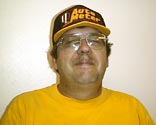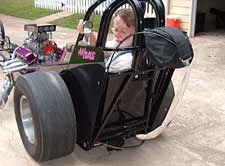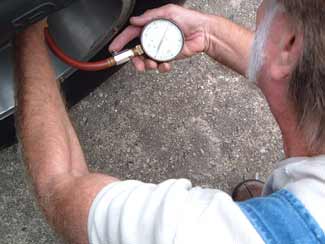|
Richard Earle’s
10 Tech Tips
These are
for dragsters, but
just about any car will do.
By Dale Wilson
Photos by Dale Wilson and Fran Gaudsmith
11/9/04
 |
Richard
Earle builds racecars. He built wife Fran’s back
in 1986. He’s been building racecars for 30 years,
starting in St. Petersburg, Fla., then moving northward
up U.S. 19 to Homosassa 15 years ago, out of his Richard
Earle’s Suncoast Race Cars shop. Richard has built
everything from Pro Stockers to Pro Modifieds to Funny
Cars to bracket cars, plus he has own mail-order business
called Suncoast Performance Products, plus a separate
company called Advance Fiberglass Concepts, which makes ‘glass
bodies. |
| When we had a problem with Fran’s hard-tail dragster,
we called the man who built it. While in the process
of telling us what to do with it, Richard kept on rattling
off these tips to use when we went racing with it. Soon
we had enough to fill a good log book. So, here they
are, in no particular order. |
 |
  “Get a good tire gauge,” Earle said. “I
think CSR’s (formerly CSI) hand-held tire gauge is
the best. It’s the most accurate gauge we’ve
been able to find. All the others out there lose their calibration.
CSR’s doesn’t. They (owner Clyde Beckenbaugh
and others) are at all the races. If your gauge needs to
be calibrated or re-checked, just take it to their trailer
and get it done. It has a large face, three inches in diameter,
an air bleed, an internal light, a rubber housing, stainless
hose and heavy-duty hardware. There are some out there that
are bigger, but they’re not as good as this one. It
goes up to 15 pounds, perfect for slicks that routinely carry
low tire pressure. That’s what it’s made for.
It’s big and therefore easy to read, and marked in
tenth-increments. We use it on everything, from bracket dragsters
to Pro Mod cars, Pro Street cars. It’s the only gauge
anybody should have in their tool box.” “Get a good tire gauge,” Earle said. “I
think CSR’s (formerly CSI) hand-held tire gauge is
the best. It’s the most accurate gauge we’ve
been able to find. All the others out there lose their calibration.
CSR’s doesn’t. They (owner Clyde Beckenbaugh
and others) are at all the races. If your gauge needs to
be calibrated or re-checked, just take it to their trailer
and get it done. It has a large face, three inches in diameter,
an air bleed, an internal light, a rubber housing, stainless
hose and heavy-duty hardware. There are some out there that
are bigger, but they’re not as good as this one. It
goes up to 15 pounds, perfect for slicks that routinely carry
low tire pressure. That’s what it’s made for.
It’s big and therefore easy to read, and marked in
tenth-increments. We use it on everything, from bracket dragsters
to Pro Mod cars, Pro Street cars. It’s the only gauge
anybody should have in their tool box.”
  “Tire pressure is very important. We
see so many people who switch from door cars to dragsters,
but they don’t really know where to set the air pressure,
so they’ll set it like it was a door car, and the dragster
weighs 500 pounds less, so it needs less air. We’ve
had some of our cars, hard tail-style, with 17x30 Goodyears,
run as little as three and ¾ pounds. To find out the
proper slick air pressure, what we tell people is to let
the air down in the tire until it is flat on the bottom,
so it has a contact patch. Just as it starts to wrinkle,
or a little before. Then find a place where you can spin
the tires up and look at the footprint. If it’s dark
on the outside edges, there’s too little air. If it’s
dark in the center, there’s too much air. You want
a footprint that’s all the way across. That’s
your starting point, and you refine from there. If you get
the car out there and it feels squishy in the back, then
it’s probably got too little air in it. Move it up
in quarter-pound increments. Get the wrinkle in the sidewall
and the footprint first, then go run the car.” “Tire pressure is very important. We
see so many people who switch from door cars to dragsters,
but they don’t really know where to set the air pressure,
so they’ll set it like it was a door car, and the dragster
weighs 500 pounds less, so it needs less air. We’ve
had some of our cars, hard tail-style, with 17x30 Goodyears,
run as little as three and ¾ pounds. To find out the
proper slick air pressure, what we tell people is to let
the air down in the tire until it is flat on the bottom,
so it has a contact patch. Just as it starts to wrinkle,
or a little before. Then find a place where you can spin
the tires up and look at the footprint. If it’s dark
on the outside edges, there’s too little air. If it’s
dark in the center, there’s too much air. You want
a footprint that’s all the way across. That’s
your starting point, and you refine from there. If you get
the car out there and it feels squishy in the back, then
it’s probably got too little air in it. Move it up
in quarter-pound increments. Get the wrinkle in the sidewall
and the footprint first, then go run the car.”

|
